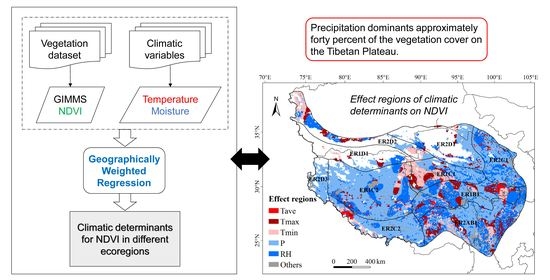Precipitation Drives the NDVI Distribution on the Tibetan Plateau While High Warming Rates May Intensify Its Ecological Droughts
Abstract
1. Introduction
2. Materials and Methods
2.1. Study Region
2.2. Climatic Variables
2.3. Normalized Difference Vegetation Index (NDVI)
2.4. Spatial Autocorrelation
2.5. Trend Analysis
2.6. Geographically Weighted Regression (GWR)
3. Results
3.1. Nonstationarity test of NDVI and Climate Change
3.2. Spatial Nonstationary Relationship Between NDVI and Climatic Factors
3.3. Climate Determinants for NDVI in Different Ecoregions
3.4. Response Pattern of the NDVI Variation to Climate Variability
4. Discussion
5. Conclusions
Author Contributions
Funding
Institutional Review Board Statement
Informed Consent Statement
Data Availability Statement
Acknowledgments
Conflicts of Interest
References
- Ji, F.; Wu, Z.H.; Huang, J.P.; Chassignet, E.P. Evolution of land surface air temperature trend. Nat. Clim. Chang. 2014, 4, 462–466. [Google Scholar] [CrossRef]
- Zhao, M.S.; Running, S.W. Drought-induced reduction in global terrestrial net primary production from 2000 through 2009. Science 2010, 329, 940–943. [Google Scholar] [CrossRef]
- Huang, N.; He, J.S.; Chen, L.T.; Wang, L. No upward shift of alpine grassland distribution on the Qinghai-Tibetan Plateau despite rapid climate warming from 2000 to 2014. Sci. Total Environ. 2018, 625, 1361–1368. [Google Scholar] [CrossRef]
- Zhang, Y.H.; Ye, A.Z. Spatial and temporal variations in vegetation coverage observed using AVHRR GIMMS and Terra MODIS data in the mainland of China. Int. J. Remote Sens. 2020, 41, 4238–4268. [Google Scholar] [CrossRef]
- Zhao, X.; Hu, H.F.; Shen, H.H.; Zhou, D.J.; Zhou, L.M.; Myneni, R.B.; Fang, J.Y. Satellite-indicated long-term vegetation changes and their drivers on the Mongolian Plateau. Landscape Ecol. 2015, 30, 1599–1611. [Google Scholar] [CrossRef]
- Franzke, C.L.E. Warming trends: Nonlinear climate change. Nat. Clim. Chang. 2014, 4, 423–424. [Google Scholar] [CrossRef]
- Loarie, S.R.; Duffy, P.B.; Hamilton, H.; Asner, G.P.; Field, C.B.; Ackerly, D.D. The velocity of climate change. Nature 2009, 462, 1052–1055. [Google Scholar] [CrossRef] [PubMed]
- Dong, B.W.; Sutton, R. Dominant role of greenhouse-gas forcing in the recovery of Sahel rainfall. Nat. Clim. Chang. 2015, 5, 757–760. [Google Scholar] [CrossRef]
- Levine, J.M. Ecology: A trail map for trait-based studies. Nature 2015, 529, 163–164. [Google Scholar] [CrossRef]
- Piao, S.L.; Zhang, X.Z.; Wang, T.; Liang, E.Y.; Wang, S.P.; Zhu, J.T.; Niu, B. Responses and feedback of the Tibetan Plateau’s alpine ecosystem to climate change. Chin. Sci. Bull. 2019, 64, 2842–2855. [Google Scholar] [CrossRef]
- Yao, T.D. Tackling on environmental changes in Tibetan Plateau with focus on water, ecosystem and adaptation. Sci. Bull. 2019, 64, 417. [Google Scholar] [CrossRef]
- Liu, L.L.; Zhang, X.Y.; Donnelly, A.; Liu, X.J. Interannual variations in spring phenology and their response to climate change across the Tibetan Plateau from 1982 to 2013. Int. J. Biometeorol. 2016, 60, 1563–1575. [Google Scholar] [CrossRef]
- Piao, S.L.; Yin, G.D.; Tan, J.G.; Cheng, L.; Huang, M.T.; Li, Y.; Liu, R.G.; Mao, J.F.; Myneni, R.B.; Peng, S.S.; et al. Detection and attribution of vegetation greening trend in China over the last 30 years. Glob. Chang. Biol. 2015, 21, 1601–1609. [Google Scholar] [CrossRef]
- Zhu, Z.C.; Piao, S.L.; Myneni, R.B.; Huang, M.T.; Zeng, Z.Z.; Canadell, J.G.; Ciais, P.; Sitch, S.; Friedlingstein, P.; Arneth, A.; et al. Greening of the earth and its drivers. Nat. Clim. Chang. 2016, 6, 791–796. [Google Scholar] [CrossRef]
- Luo, X.; Jia, B.H.; Lai, X. Contributions of climate change, land use change and CO2 to changes in the gross primary productivity of the Tibetan Plateau. Atmos. Ocean. Sci. Lett. 2020, 13, 8–15. [Google Scholar] [CrossRef]
- Fu, G.; Zhang, X.Z.; Zhang, Y.J.; Shi, P.L.; Li, Y.L.; Zhou, Y.T.; Yang, P.W.; Shen, Z.X. Experimental warming does not enhance gross primary production and above-ground biomass in the alpine meadow of Tibet. J. Appl. Remote Sens. 2013, 7, 6451–6465. [Google Scholar] [CrossRef]
- Crausbay, S.D.; Ramirez, A.R.; Carter, S.L.; Cross, M.S.; Hall, K.R.; Bathke, D.J.; Betancourt, J.L.; Colt, S.; Cravens, A.E.; Dalton, M.S.; et al. Defining ecological drought for the twenty-first century. Bull. Am. Meteorol. Soc. 2017, 98, 2543–2550. [Google Scholar] [CrossRef]
- Zeng, B.; Yang, T.B. Impacts of climate warming on vegetation in Qaidam Area from 1990 to 2003. Environ. Monit. Assess. 2008, 144, 403–417. [Google Scholar] [CrossRef] [PubMed]
- Reyer, C.P.O.; Leuzinger, S.; Rammig, A.; Wolf, A.; Bartholomeus, R.P.; Bonfante, A.; de Lorenzi, F.; Dury, M.; Gloning, P.; Abou Jaoude, R.; et al. A plant’s perspective of extremes: Terrestrial plant responses to changing climatic variability. Glob. Chang. Biol. 2013, 19, 75–89. [Google Scholar] [CrossRef] [PubMed]
- Fridley, J.D.; Lynn, J.S.; Grime, J.P.; Askew, A.P. Longer growing seasons shift grassland vegetation towards more-productive species. Nat. Clim. Chang. 2016, 6, 865–868. [Google Scholar] [CrossRef]
- Zhang, Y.L.; Qi, W.; Zhou, C.P.; Ding, M.J.; Liu, L.S.; Gao, J.G.; Bai, W.Q.; Wang, Z.F.; Zheng, D. Spatial and temporal variability in the net primary production of alpine grassland on the Tibetan Plateau since 1982. J. Geogr. Sci. 2014, 24, 269–287. [Google Scholar] [CrossRef]
- Zheng, D. Research on Eco-Geographical Region Systems of China; The Commercial Press: Beijing, China, 2008; pp. 284–295. [Google Scholar]
- Alcaraz-Segura, D.; Chuvieco, E.; Epstein, H.E.; Kasischke, E.S.; Trishchenko, A. Debating the greening vs. browning of the North American boreal forest: Differences between satellite datasets. Glob. Chang. Biol. 2010, 16, 760–770. [Google Scholar] [CrossRef]
- Mao, D.H.; Wang, Z.M.; Luo, L.; Ren, C.Y. Integrating AVHRR and MODIS data to monitor NDVI changes and their relationships with climatic parameters in Northeast China. Int. J. Appl. Earth Obs. 2012, 18, 528–536. [Google Scholar] [CrossRef]
- Li, Y.; Xie, Z.X.; Qin, Y.C.; Zheng, Z.C. Estimating relations of vegetation, climate change, and human activity: A case study in the 400 mm annual precipitation fluctuation zone, China. Remote Sens. 2019, 11, 1159. [Google Scholar] [CrossRef]
- Shen, M.G.; Piao, S.L.; Jeong, S.J.; Zhou, L.M.; Zeng, Z.Z.; Ciais, P.; Chen, D.L.; Huang, M.T.; Jin, C.S.; Li, L.Z.X.; et al. Evaporative cooling over the Tibetan Plateau induced by vegetation growth. Proc. Natl. Acad. Sci. USA 2015, 112, 9299–9304. [Google Scholar] [CrossRef]
- Szymanowski, M.; Kryza, M. Local regression models for spatial interpolation of urban heat island—an example from Wrocaw, SW Poland. Theor. Appl. Climatol. 2012, 108, 53–71. [Google Scholar] [CrossRef]
- Sun, J.; Cheng, G.W.; Li, W.P.; Sha, Y.K.; Yang, Y.C. On the variation of NDVI with the principal climatic elements in the Tibetan Plateau. Remote Sens. 2013, 5, 1894–1911. [Google Scholar] [CrossRef]
- Brunsdon, C.; Fotheringham, A.S.; Charlton, M.E. Geographically weighted regression: A method for exploring spatial nonstationarity. Geogr. Anal. 1996, 28, 281–298. [Google Scholar] [CrossRef]
- Brown, S.; Versace, V.L.; Laurenson, L.; Ierodiaconou, D.; Fawcett, J.; Salzman, S. Assessment of spatiotemporal varying relationships between rainfall, land cover and surface water area using geographically weighted regression. Environ. Model. Assess. 2012, 17, 241–254. [Google Scholar] [CrossRef]
- Gao, J.B.; Jiao, K.W.; Wu, S.H. Quantitative assessment of ecosystem vulnerability to climate change: Methodology and application in China. Environ. Res. Lett. 2018, 13, 094016. [Google Scholar] [CrossRef]
- Shen, Z.X.; Fu, G.; Yu, C.Q.; Sun, W.; Zhang, X.Z. Relationship between the growing season maximum enhanced vegetation index and climatic factors on the Tibetan Plateau. Remote Sens. 2014, 6, 6765–6789. [Google Scholar] [CrossRef]
- Shi, C.M.; Wang, K.C.; Sun, C.; Zhang, Y.D.; He, Y.Y.; Wu, X.X.; Gao, C.; Wu, G.C.; Shu, L.F. Significantly lower summer minimum temperature warming trend on the Southern Tibetan Plateau than over the Eurasian continent since the Industrial Revolution. Environ. Res. Lett. 2019, 14, 124033. [Google Scholar] [CrossRef]
- Gao, J.B.; Jiao, K.W.; Wu, S.H.; Ma, D.Y.; Zhao, D.S.; Yin, Y.H.; Dai, E.F. Past and future effects of climate change on spatially heterogeneous vegetation activity in China. Earth’s Future 2017, 5, 679–692. [Google Scholar] [CrossRef]
- Piao, S.L.; Wang, X.H.; Ciais, P.; Zhu, B.; Wang, T.; Liu, J. Changes in satellite-derived vegetation growth trend in temperate and boreal Eurasia from 1982 to 2006. Glob. Chang. Biol. 2011, 17, 3228–3239. [Google Scholar] [CrossRef]
- Urban, M.C. Accelerating extinction risk from climate change. Science 2015, 348, 571–573. [Google Scholar] [CrossRef] [PubMed]
- Michaletz, S.T.; Cheng, D.L.; Kerkhoff, A.J.; Enquist, B.J. Convergence of terrestrial plant production across global climate gradients. Nature 2014, 512, 39–43. [Google Scholar] [CrossRef] [PubMed]
- Brohan, P.; Kennedy, J.J.; Harris, I.; Tett, S.F.B.; Jones, P.D. Uncertainty estimates in regional and global observed temperature changes: A new data set from 1850. J. Geophys. Res. Atmos. 2006, 111, 121–133. [Google Scholar] [CrossRef]
- Meng, F.D.; Ji, S.N.; Zhang, Z.H.; Wang, S.P.; Duan, J.C.; Wang, Q.; Li, B.W.; Luo, C.Y.; Jiang, L.L.; Zhang, L.R.; et al. Nonlinear responses of temperature sensitivities of community phenophases to warming and cooling events are mirroring plant functional diversity. Agr. Forest Meteorol. 2018, 253, 31–37. [Google Scholar] [CrossRef]
- Peng, W.F.; Kuang, T.T.; Tao, S. Quantifying influences of natural factors on vegetation NDVI changes based on geographical detector in Sichuan, western China. J. Clean. Prod. 2019, 233, 353–367. [Google Scholar] [CrossRef]
- Wang, X.Y.; Wang, T.; Liu, D.; Zhang, T.T.; Xu, J.F.; Cui, G.S.; Lv, G.T.; Huang, H.B. Multisatellite analyses of spatiotemporal variability in photosynthetic activity over the Tibetan Plateau. J. Geophys. Res. Biogeo. 2019, 124, 3778–3797. [Google Scholar] [CrossRef]
- Wang, Q.; Ni, J.; Tenhunen, J. Application of a geographically-weighted regression analysis to estimate net primary production of Chinese forest ecosystems. Global Ecol. Biogeogr. 2005, 14, 379–393. [Google Scholar] [CrossRef]
- Peng, S.S.; Piao, S.L.; Ciais, P.; Myneni, R.B.; Chen, A.P.; Chevallier, F.; Dolman, A.J.; Janssens, I.A.; Penuelas, J.; Zhang, G.X.; et al. Asymmetric effects of daytime and night-time warming on northern hemisphere vegetation. Nature 2013, 501, 88–92. [Google Scholar] [CrossRef]
- Tian, L.; Gong, Q.W.; Chen, J.Q. Coupled dynamics of socioeconomic and environmental systems in Tibet. Environ. Res. Lett. 2018, 13, 034001. [Google Scholar] [CrossRef]
- Wang, D.; Li, X.X.; Zou, D.F.; Wu, T.H.; Xu, H.Y.; Hu, G.J.; Li, R.; Ding, Y.J.; Zhao, L.; Li, W.P.; et al. Modeling soil organic carbon spatial distribution for a complex terrain based on geographically weighted regression in the eastern Qinghai-Tibetan Plateau. Catena 2020, 187, 104399. [Google Scholar] [CrossRef]
- Ren, G.H.; Shang, Z.H.; Long, R.J.; Hou, Y.; Deng, B. The relationship of vegetation and soil differentiation during the formation of black-soil-type degraded meadows in the headwater of the Qinghai-Tibetan Plateau, China. Environ. Earth Sci. 2013, 69, 235–245. [Google Scholar] [CrossRef]
- Li, P.; Peng, C.H.; Wang, M.; Luo, Y.P.; Li, M.X.; Zhang, K.R.; Zhang, D.L.; Zhu, Q.A. Dynamics of vegetation autumn phenology and its response to multiple environmental factors from 1982 to 2012 on Qinghai-Tibetan Plateau in China. Sci. Total Environ. 2018, 637, 855–864. [Google Scholar] [CrossRef] [PubMed]
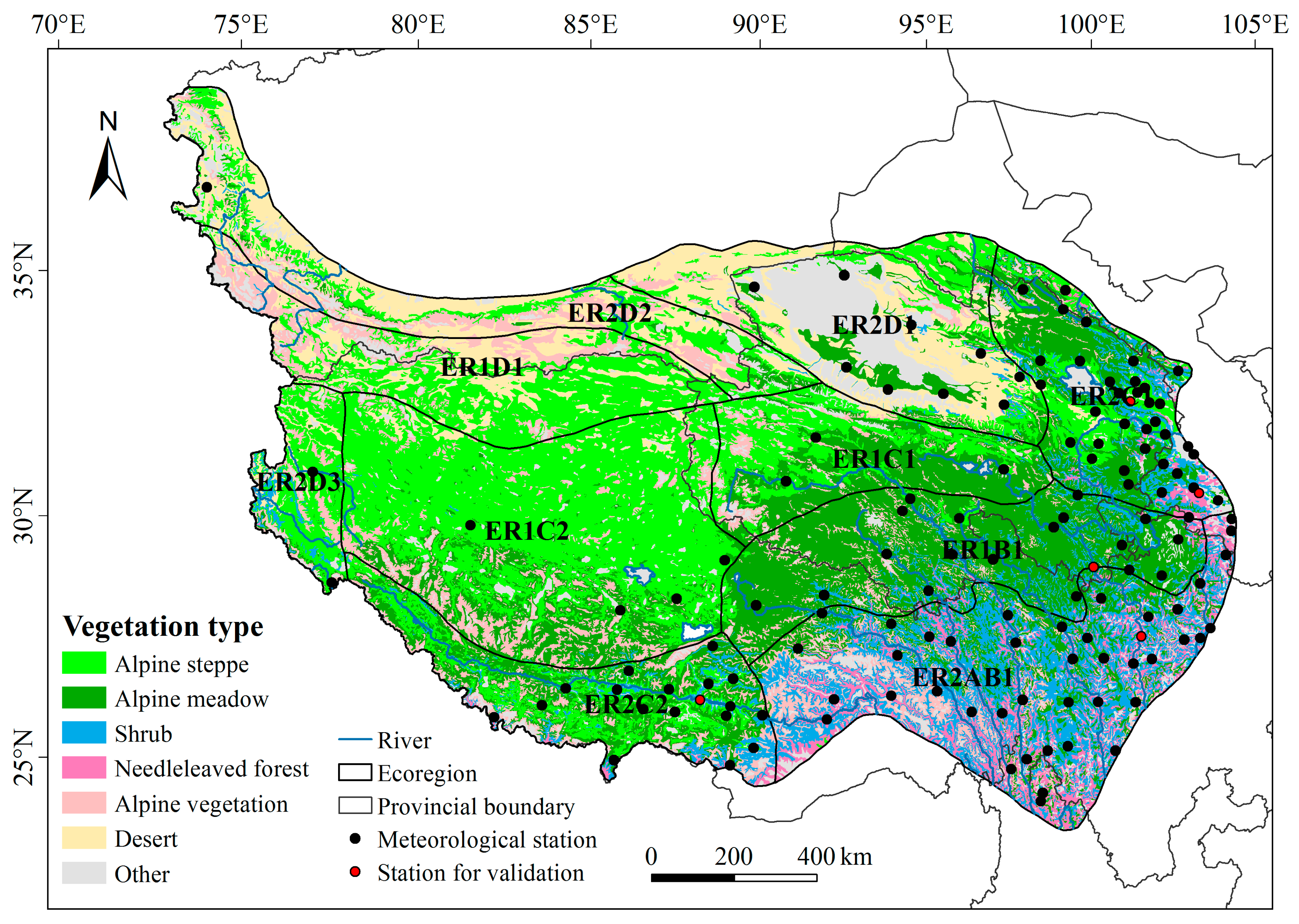
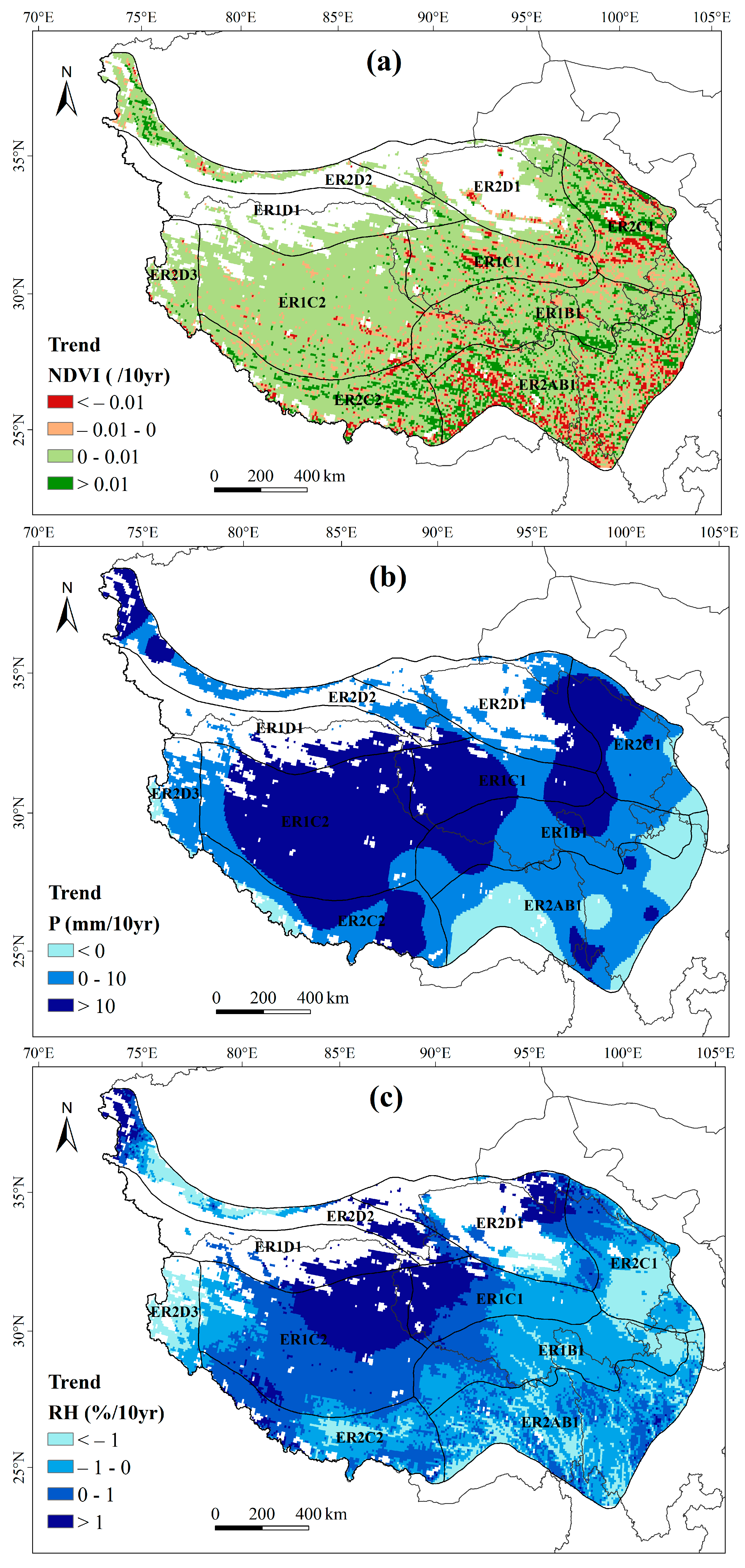
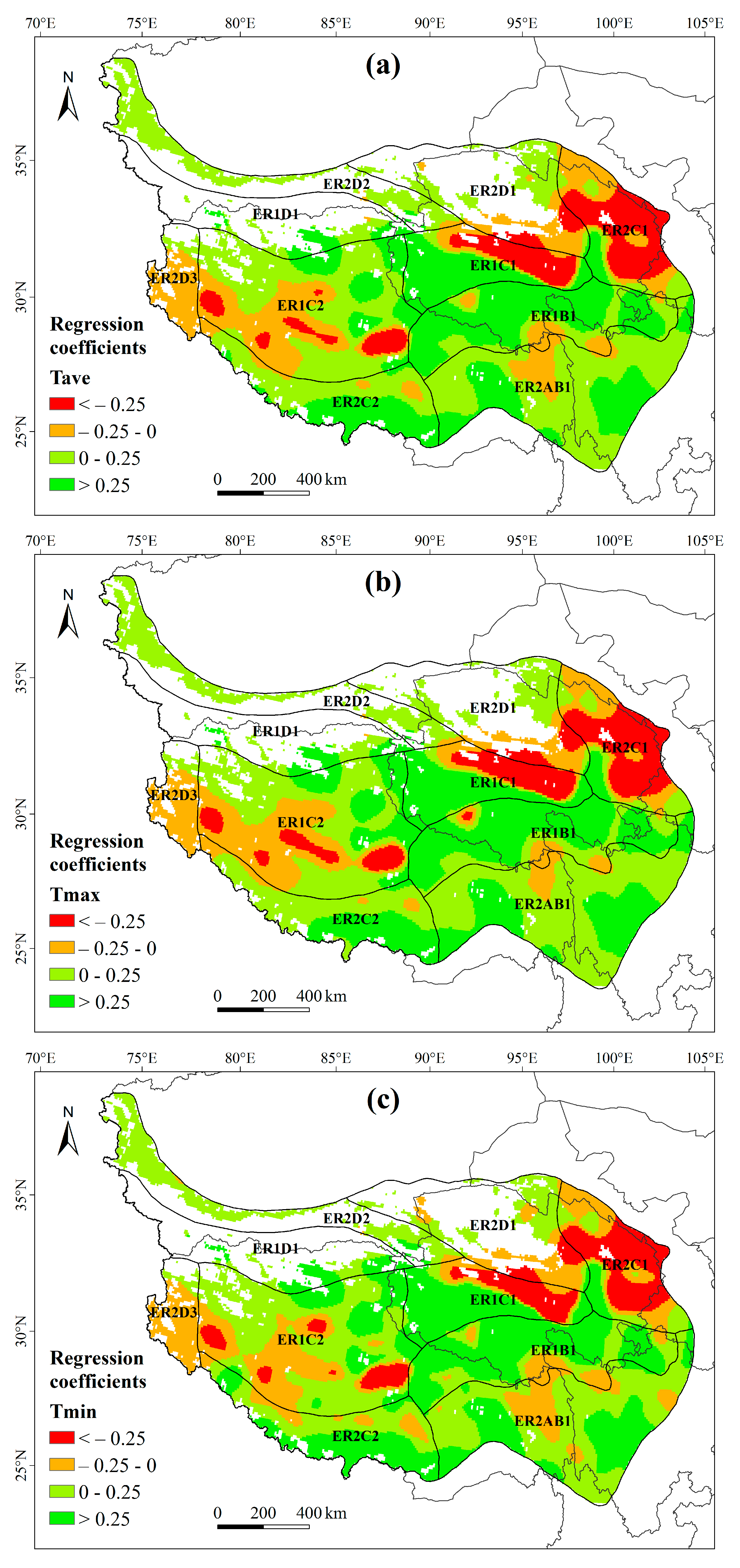
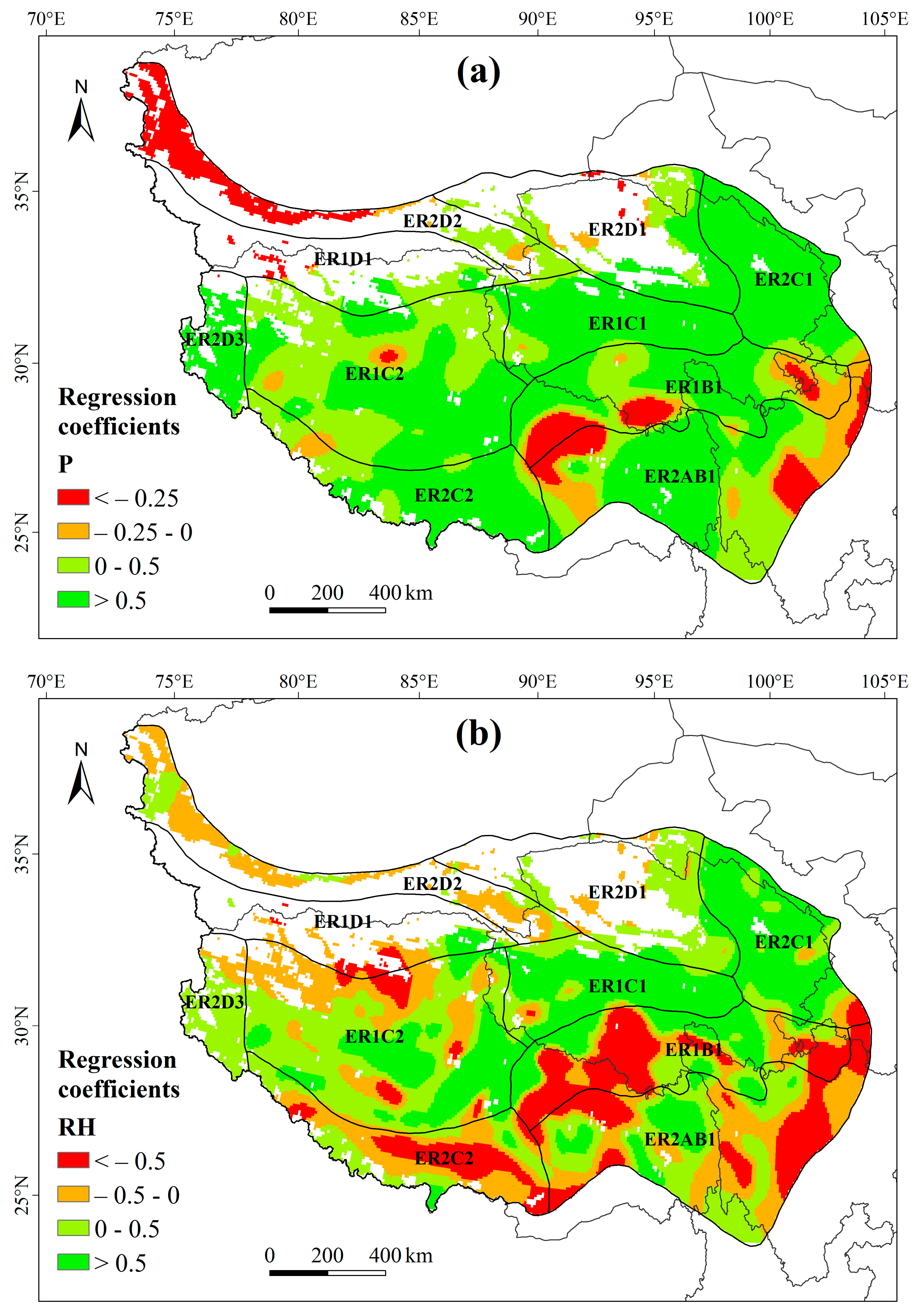
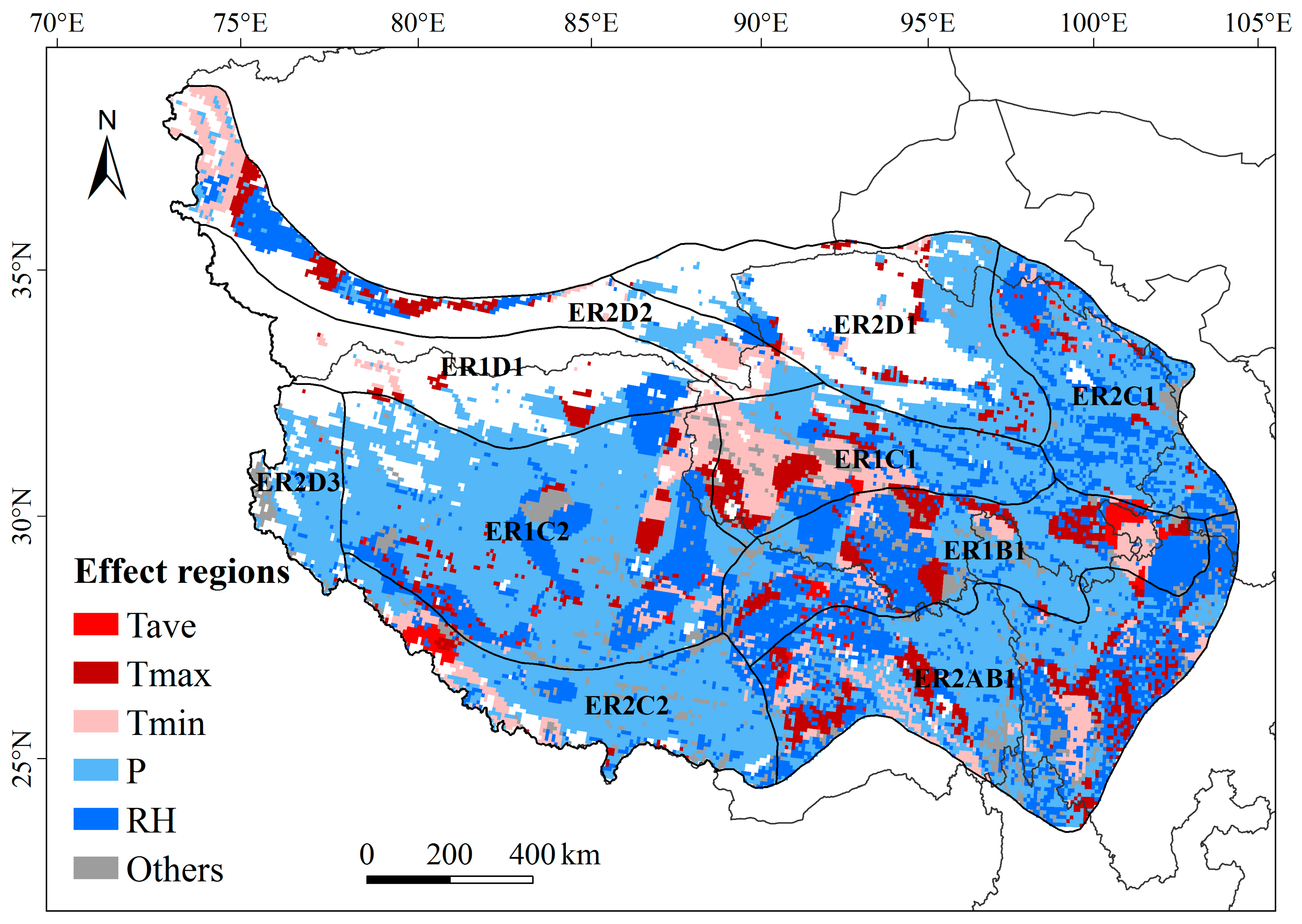
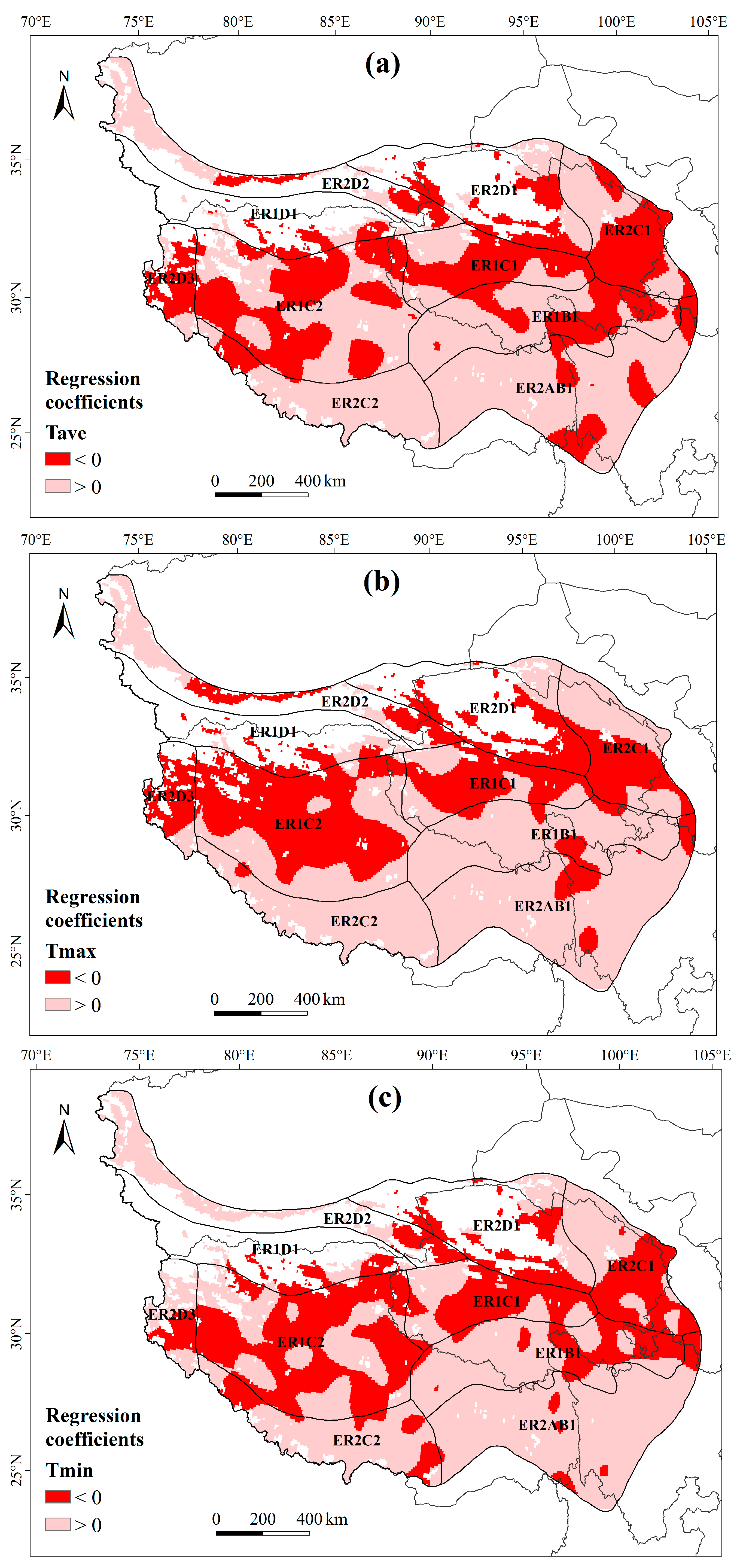
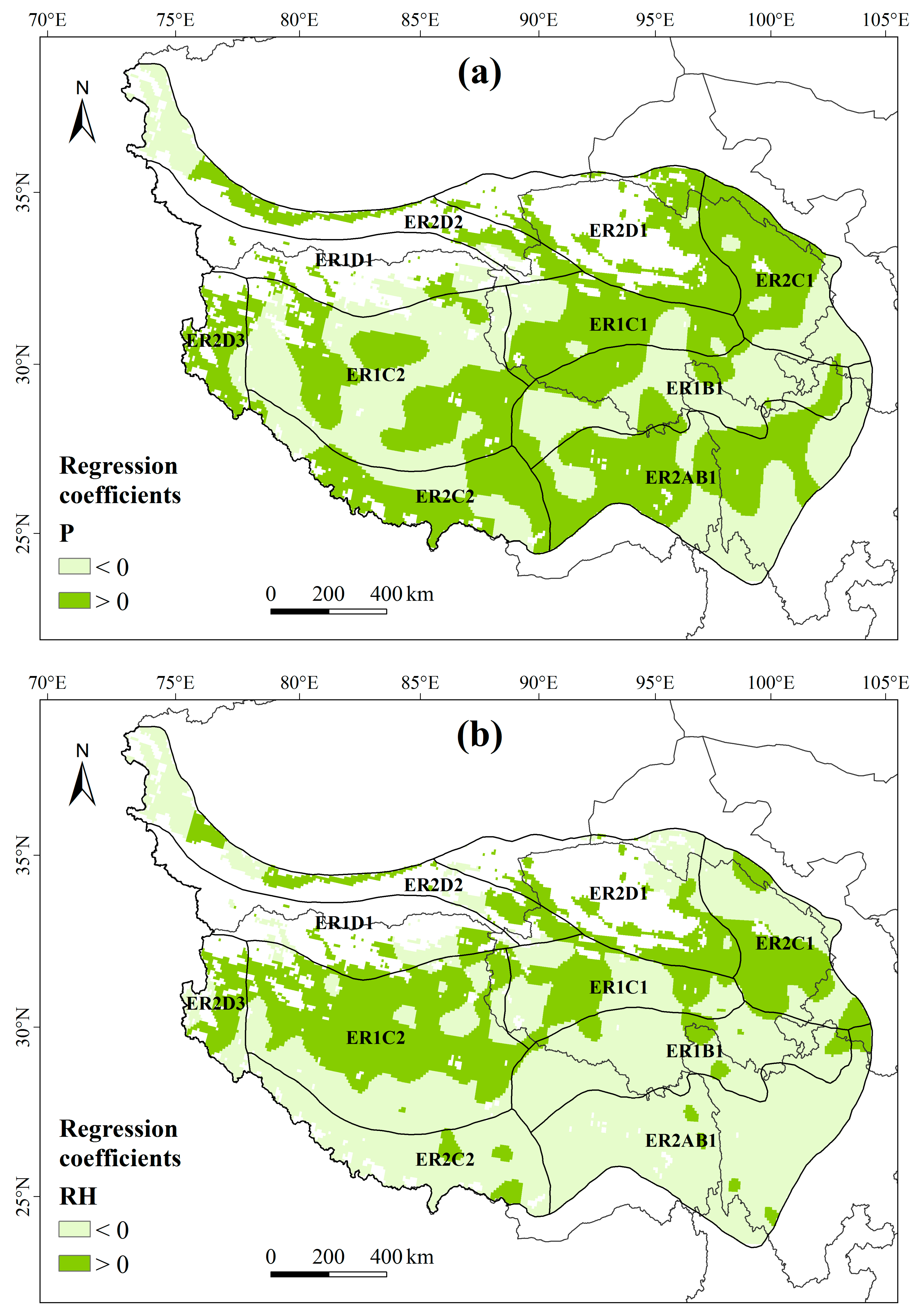
| Temperature Zones | Humidity Regions | Eco-Geographical Regions |
|---|---|---|
| ER1: Plateau sub-cold zone | B: Sub-humid region | ER1B1: Guoluo-Naqu Plateau mountain alpine shrub-meadow region |
| C: Semiarid region | ER1C1: Southern Qinghai Plateau and wide valley alpine meadow-steppe region | |
| ER1C2: Qiangtang Plateau lake basin alpine steppe region | ||
| D: Arid region | ER1D1: Kunlun high mountain and plateau alpine desert region | |
| ER2: Plateau temperature zone | A/B: Humid/sub-humid region | ER2A/B1: Western Sichuan and Eastern Xizang high mountain and deep valley coniferous forest region |
| C: Semiarid region | ER2C1: Qilian Mountains of eastern Qinghai high mountain and basin coniferous forest and steppe region | |
| ER2C2: Southern Xizang high mountain and valley shrub-steppe region | ||
| D: Arid region | ER2D1: Qaidam Basin desert region | |
| ER2D2: North Kunlun mountain desert region | ||
| ER2D3: Ngali mountain desert region |
| Regression Coefficients | Tave | Tmax | Tmin | P | RH | |
|---|---|---|---|---|---|---|
| Normalization | Moran’s I | 0.94 | 0.95 | 0.92 | 0.83 | 0.90 |
| Z | 117.0 | 118.7 | 114.3 | 103.6 | 111.5 | |
| Variability | Moran’s I | 0.93 | 0.97 | 0.89 | 0.83 | 0.90 |
| Z | 116.5 | 120.3 | 111.3 | 103.6 | 112.6 | |
| Eco-Geographical Regions | Tave | Tmax | Tmin | P | RH | |||||
|---|---|---|---|---|---|---|---|---|---|---|
| Mean /°C | Trend /°C 10yr−1 | Mean /°C | Trend /°C 10yr−1 | Mean /°C | Trend /°C 10yr−1 | Mean /mm | Trend /mm 10yr−1 | Mean /% | Trend /% 10yr−1 | |
| ER1B1 | 27.9 | 0.44 | 28.6 | 0.45 | 27.4 | 0.67 | 465.0 | 8.6 | 69.7 | −0.46 |
| ER1C1 | 27.7 | 0.48 | 28.4 | 0.38 | 27.2 | 0.77 | 243.8 | 19.8 | 60.7 | 0.42 |
| ER1C2 | 27.8 | 0.43 | 28.5 | 0.36 | 27.2 | 0.75 | 207.8 | 19.1 | 52.4 | 0.73 |
| ER2A/B1 | 28.3 | 0.32 | 29.0 | 0.43 | 27.8 | 0.50 | 516.4 | 0.5 | 71.1 | −0.52 |
| ER2C1 | 28.2 | 0.51 | 28.8 | 0.42 | 27.6 | 0.65 | 337.1 | 9.1 | 65.8 | −0.66 |
| ER2C2 | 28.0 | 0.28 | 28.7 | 0.31 | 27.5 | 0.58 | 315.6 | 8.8 | 64.3 | −0.12 |
| ER2D3 | 28.1 | 0.53 | 28.8 | 0.41 | 27.4 | 0.79 | 62.8 | 2.1 | 43.8 | −1.35 |
| Tibetan Plateau | 28.0 | 0.42 | 28.7 | 0.39 | 27.5 | 0.66 | 311.7 | 10.5 | 60.7 | 0.003 |
| Eco-Geographical Regions | Tave | Tmax | Tmin | P | RH | Others |
|---|---|---|---|---|---|---|
| ER1B1 | 3.4 | 11.6 | 8.3 | 32.6 | 36.2 | 7.7 |
| ER1C1 | 1.1 | 11.4 | 20.9 | 39.9 | 16.7 | 6.4 |
| ER1C2 | 0.4 | 4.2 | 5.1 | 59.1 | 20.2 | 4.8 |
| ER2A/B1 | 1.1 | 10.8 | 8.5 | 39.9 | 31.8 | 7.0 |
| ER2C1 | 2.1 | 1.8 | 2.2 | 57.6 | 31.6 | 3.5 |
| ER2C2 | 2.6 | 1.7 | 6.6 | 63.4 | 12.0 | 6.9 |
| ER2D3 | 0.1 | 0.3 | 0 | 55.2 | 3.1 | 6.7 |
| Tibetan Plateau | 1.1 | 6.2 | 7.1 | 39.7 | 19.3 | 4.3 |
Publisher’s Note: MDPI stays neutral with regard to jurisdictional claims in published maps and institutional affiliations. |
© 2021 by the authors. Licensee MDPI, Basel, Switzerland. This article is an open access article distributed under the terms and conditions of the Creative Commons Attribution (CC BY) license (http://creativecommons.org/licenses/by/4.0/).
Share and Cite
Jiao, K.; Gao, J.; Liu, Z. Precipitation Drives the NDVI Distribution on the Tibetan Plateau While High Warming Rates May Intensify Its Ecological Droughts. Remote Sens. 2021, 13, 1305. https://doi.org/10.3390/rs13071305
Jiao K, Gao J, Liu Z. Precipitation Drives the NDVI Distribution on the Tibetan Plateau While High Warming Rates May Intensify Its Ecological Droughts. Remote Sensing. 2021; 13(7):1305. https://doi.org/10.3390/rs13071305
Chicago/Turabian StyleJiao, Kewei, Jiangbo Gao, and Zhihua Liu. 2021. "Precipitation Drives the NDVI Distribution on the Tibetan Plateau While High Warming Rates May Intensify Its Ecological Droughts" Remote Sensing 13, no. 7: 1305. https://doi.org/10.3390/rs13071305
APA StyleJiao, K., Gao, J., & Liu, Z. (2021). Precipitation Drives the NDVI Distribution on the Tibetan Plateau While High Warming Rates May Intensify Its Ecological Droughts. Remote Sensing, 13(7), 1305. https://doi.org/10.3390/rs13071305






